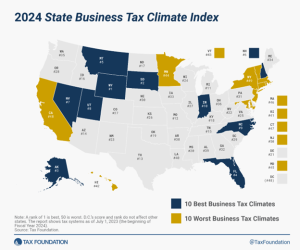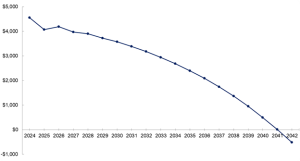Kansas’s state government has a spending problem, not a revenue problem. The upcoming Responsible Kansas Budget for FY 2025 would place a strong fiscal rule on legislators that represents the average taxpayer’s ability to pay for government spending. Responsible budgeting would allow the Legislature to deliver substantial tax relief and place sustainable controls on the future rate of increase in the tax burden and in state spending if done appropriately.
Legislators should first look for tax relief of burdensome personal income taxes that have a progressive top tax rate of 5.7%, for which Kansas ranks 28th in the country. The lowest flat income tax rate could soon be in North Carolina at 2.49%.

Tax Relief Scenarios
The 2023 report Reforming Kansas Tax Policy was a collaboration between Kansas Policy Institute and the Buckeye Institute of Ohio that modeled five different tax relief scenarios and their effects on the state’s budget and economic growth.
The first scenario represents a combination tax package similar to SB 169, a flat tax bill vetoed by Governor Laura Kelly that failed to be overridden during the 2023 Legislative Session. The scenario models a $370 million personal income tax cut, a $50 million corporate income tax cut, and a $50 million sales tax cut. This package would support $390 million more in economic growth and $220 million more in business investment in the first year compared with the baseline scenario.
The scenario that produced the most growth was a $500 million corporate income tax cut that supported $550 million more in economic growth and $360 million more in business investment than the baseline scenario. Another scenario with a $500 million personal income tax cut was close behind with $430 million more in economic growth and $240 million more in business investment.
Given these scenarios, the first scenario offers the most balanced way to provide relief to the most constituents ranging from everyday families to small businesses.
Putting Individual Income Taxes on a Path to Elimination
While these scenarios would improve the state’s competitiveness and, more importantly, better the livelihoods of Kansans, the Legislature should work to advance a path to eliminate income taxes through responsible budgeting. The state would join just seven other states without individual income taxes. There are opportunities to achieve a path to zero, as Figure 2 shows that state funds have increased far faster than the average rate of population growth plus inflation over the last decade. Based on the latest Consensus Revenue Estimate data, it would take about $80 million in surplus funds to reduce each 0.1-percentage point of the 5.7% income tax rate on a static basis.
We consider all state funds, which are what we include in the RKB above and are 73% of the total budget (i.e., state funds plus federal funds). State funds includes general funds, which are 39% of all funds or 54% of state funds. We do so because legislators have the most discretion over general funds. But they also have control over state funds and even all funds, which includes federal funds, but those have more tradeoffs associated with them. The state is estimated to collect $4.6 billion in individual income taxes in FY 2024.
Here are the income tax relief options, based on the latest Consensus Revenue forecast, that were missed for potential surpluses of general funds and state funds appropriations above the rate of population growth plus inflation:
- General Funds:
- Lower general funds appropriations of $2.3 billion in FY 2024 could have helped flatten personal income taxes and reduced the flat rate substantially, as this amount is about half of personal income taxes collected.
- The cumulative amount of lower appropriations per year over the last decade of $12 billion could have also substantially reduced income taxes over that decade, if not eliminated entirely.
- State Funds (i.e., general funds plus other funds):
- Lower appropriations of $6.4 billion for FY 2024 would have eliminated personal income taxes.
- The cumulative amount of lower appropriations over the last decade of $46.6 billion could have also substantially reduced income taxes over time, if not eliminated them.
The state’s Consensus Revenue Estimate of $10.3 billion in general revenue results in an annual average increase of 6.3% over the last decade. The average annual rate of population growth plus inflation has increased by 2.6%, resulting in an annual surplus of 3.6%. Individual income taxes of $4.6 billion in FY 2024 have grown by 7.9% over that decade.
The below figure illustrates that by using 85% of the expected surplus each year to permanently reduce the individual income tax rate, those taxes could be eliminated by 2042.
Elimination of Individual Income Taxes with Surplus General Revenue, Millions of $

These projections, however, are based on a “static” analysis without incentive effects from lower income tax rates that would support more economic activity. The increased economic activity from “dynamic” effects would support more job growth and higher wages that could result in increased general fund revenue. This would then contribute to offsetting the static revenue decline from lower income tax rates and speed up the elimination of state income taxes.
Moreover, if general fund appropriations are limited to lower than the rate of population growth plus inflation to correct for past excesses, there would likely be larger surpluses. Given that these are pro-growth policies, Kansas could eliminate individual income taxes, and even corporate income taxes, much faster than in 2042. Given our assumptions and the possibility of much better results, our estimates are very conservative.





